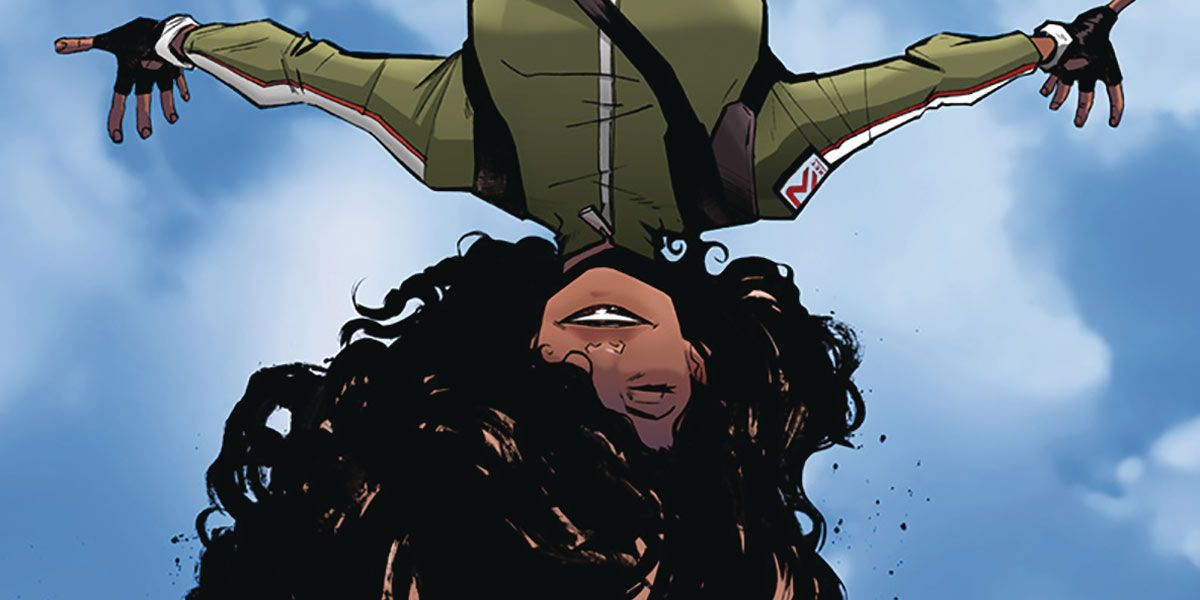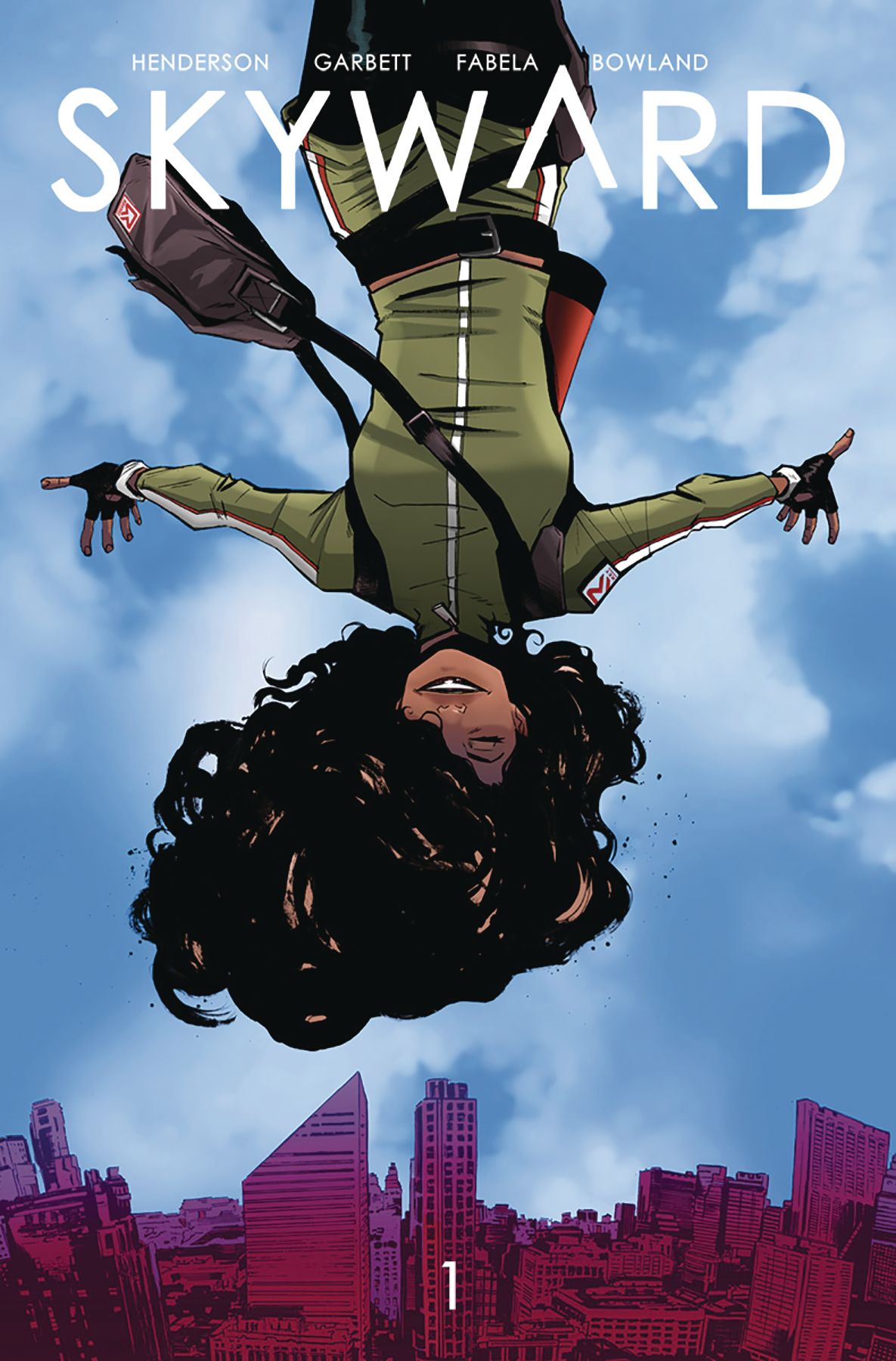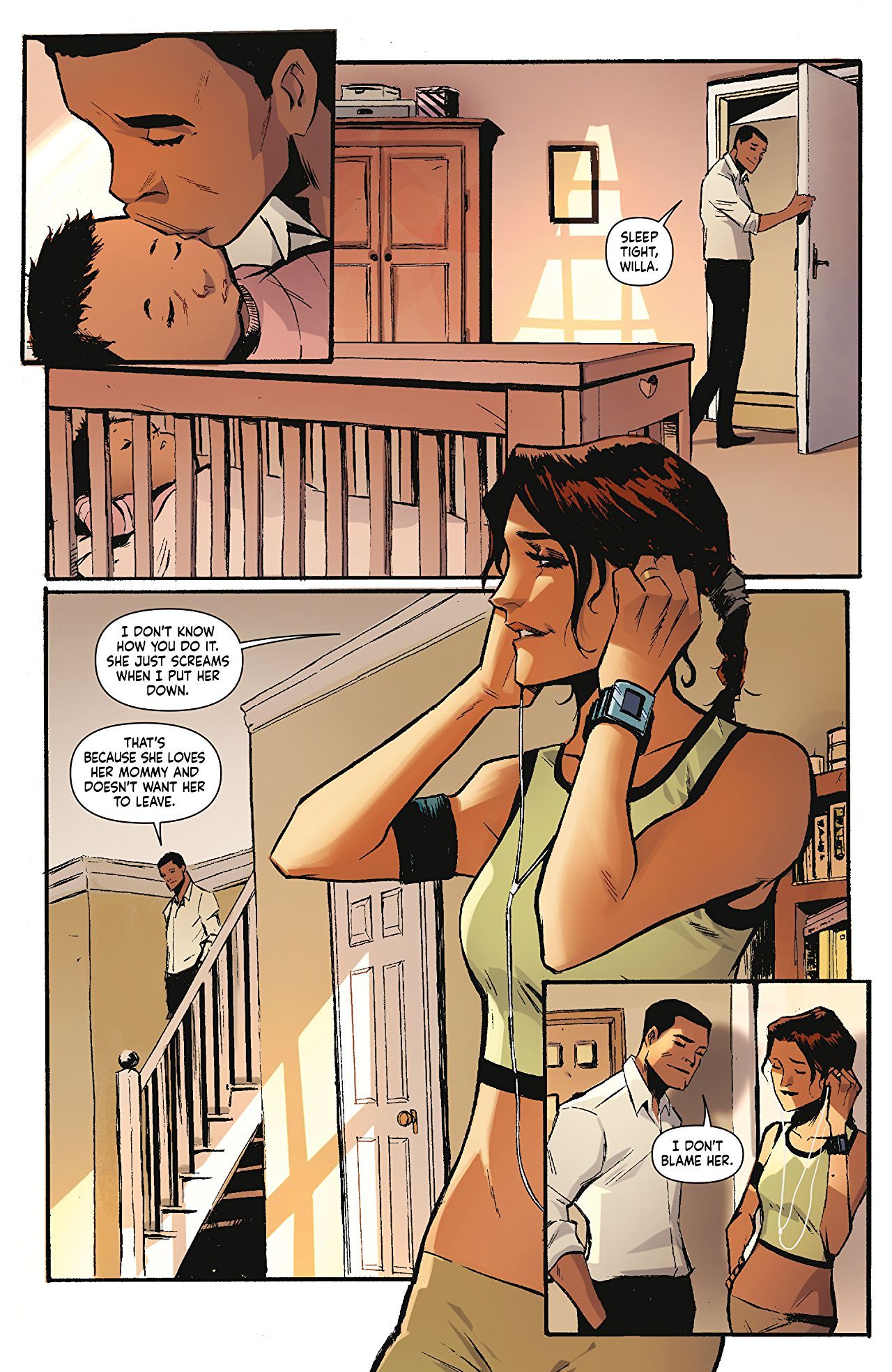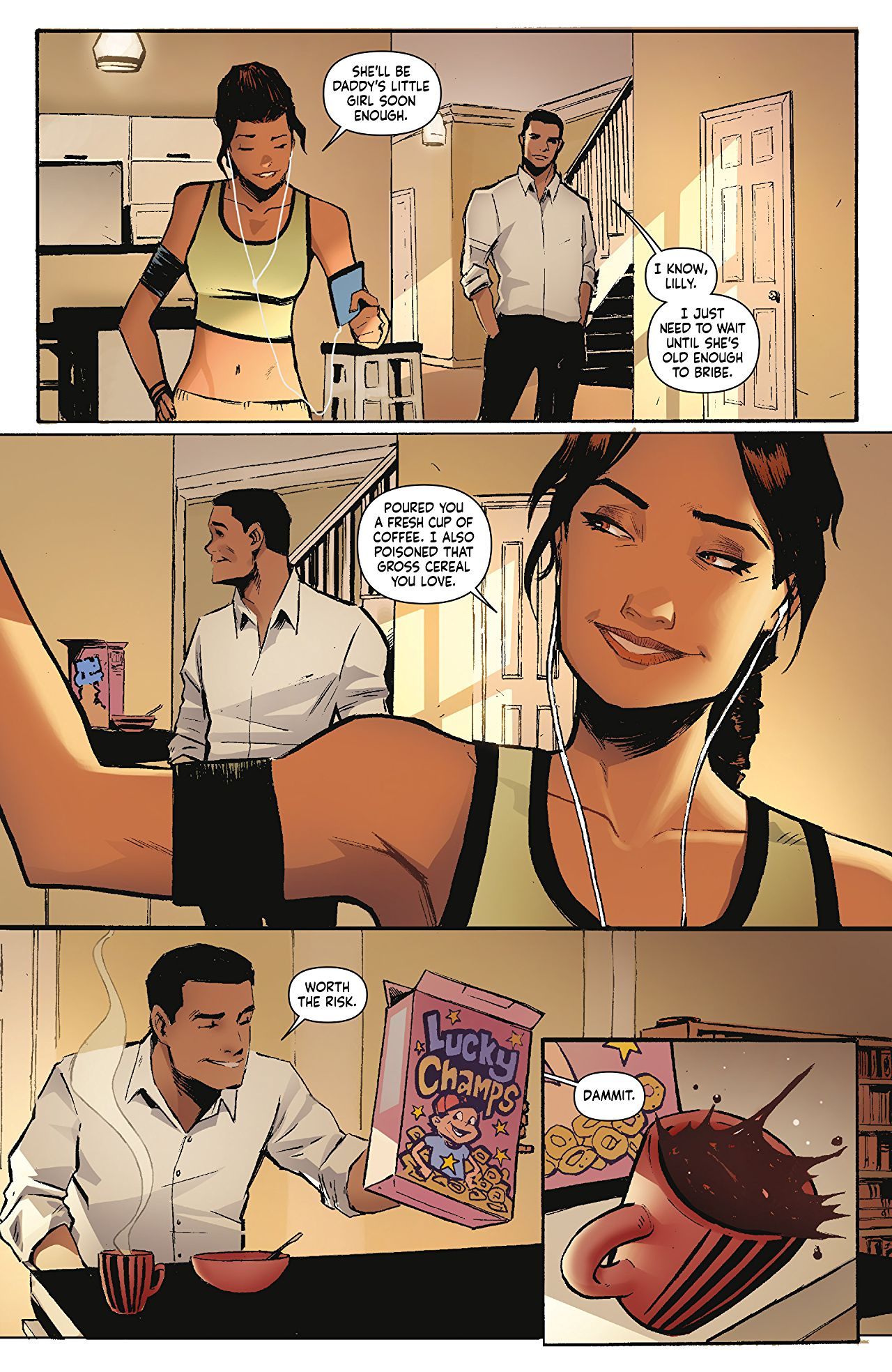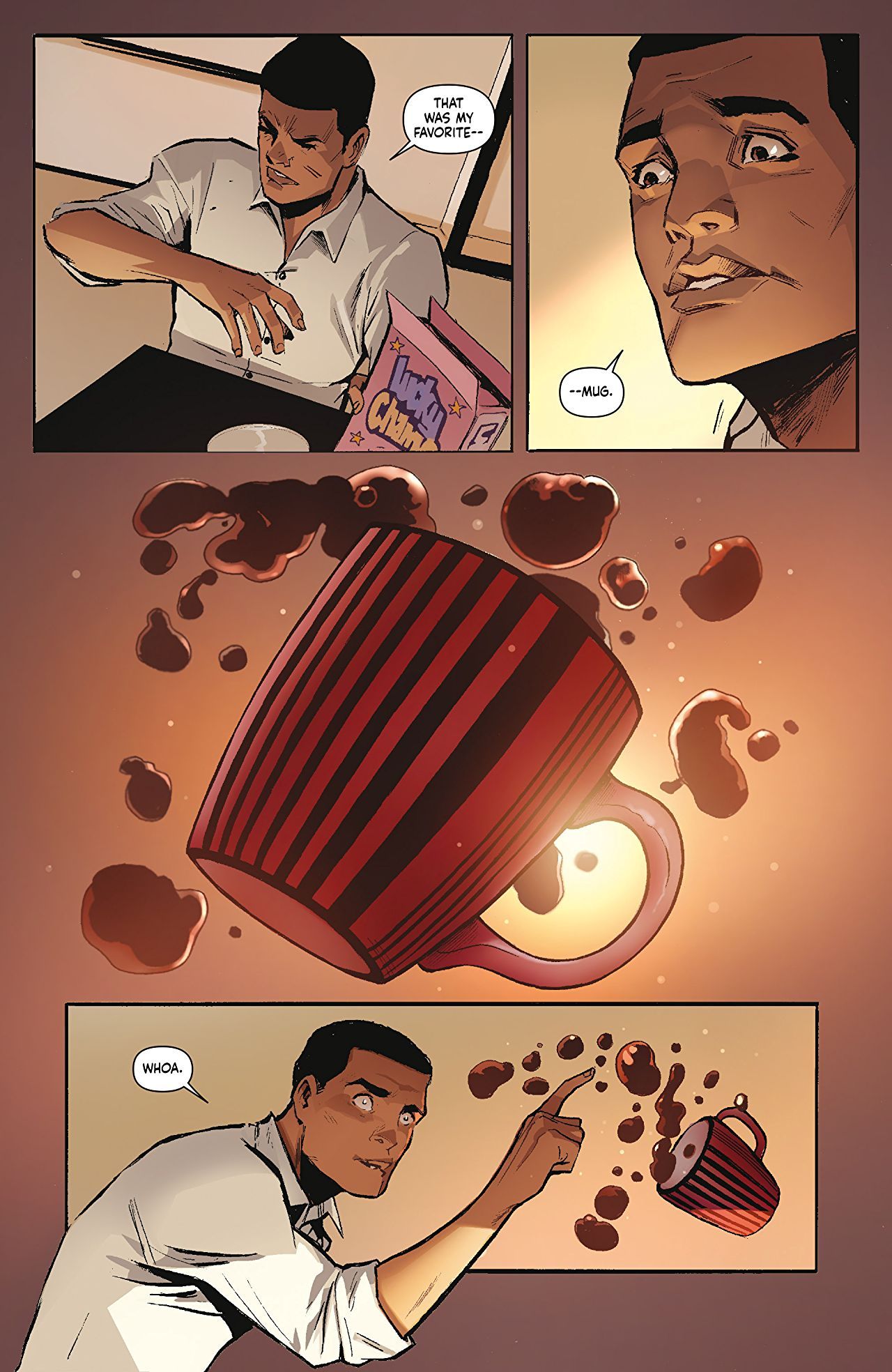New Image Comics series Skyward arrives with not only a unique high concept -- a world in which gravity has been greatly depleted, meaning much of normal life is conducting while floating in midair -- but also an unexpected creative team. Joe Henderson is a first-time comic book writer, and Lee Garbett is one of the more prolific superhero artists of the past decade, with credits including Batgirl and Loki: Agent of Asgard.
Yet it's their shared connection with a certain charming devil that helped make this pairing happen: Henderson, a TV writer who's worked on White Collar, Almost Human and more, is the current showrunner of Fox's Lucifer, based on the DC/Vertigo character. Garbett illustrated DC's recent Lucifer comic book series, which was launched to coincide with the success of the TV show. Though they have never actually worked together prior to Skyward, a social media connection between the two provided enough of a spark to make the freshly debuted creator-owned series a reality.
RELATED: Image Comics’ Full Image Expo 2018 Announcements
CBR spoke with both Henderson and Garbett about Skyward, which stars Willa Fowler, a young courier who has only known life in a gravity-deficient world, having been born after "G-day" -- the day the laws of physics changed. Henderson and Garbett spoke about the origins of their collaboration, building a world mostly sans gravity, their approach to bringing authenticity to diverse characters and the different types of stories they're looking to tell in the 15-issue run of Skyward.
CBR: Joe, Lee, I know that you both have a shared history with the character Lucifer, but I'm curious -- how did this pairing come about, specifically to make Skyward a reality?
Joe Henderson: It’s funny, the tagline for the book is a bit odd: “From the writer and artist of Lucifer! Er, kind of. Because one’s from the TV show, one’s from the comic, and they’ve never worked together before.” Super catchy, right?
I’ve been a longtime fan of Lee’s since Loki: Agent of Asgard. On that book, he did exactly the kind of thing I needed for Skyward -- taking big, crazy ideas and imbuing them with humanity. We’d tweeted back and forth a little bit due to the Lucifer connection. So, when I went looking for an artist, I sent him a DM asking if he could recommend anyone. Secretly, I was hoping he’d want to do it. But come on. What were the chances?
Lee Garbett: Haha. Yeah, that was a pretty cool day. “The showrunner of TV’s Lucifer has DM’d me!?!” As I read it I hoped the angle was that I’d be interested, too but I was equally aware Joe may have genuinely wanted me to recommend somebody else.
But tough! I’d read it first, fell in love instantly and refused to let anyone else near it. I’m not a believer in fate but this was as near as it gets. It struck such a chord with me. It couldn’t have felt more natural a fit than if we’d collaborated on it from the outset.
Joe, this is your first comic book writing credit, but obviously you've spent time in the world as the showrunner of a DC-based TV show, and, of course, a comic book fan. Has writing comics always been a goal for you? What was the transition from TV to comics like?
Henderson: It has -- I’m a longtime reader and have a frighteningly encyclopedic knowledge of late ’80s, early ’90s Marvel comics. (Ask me anything about Darkhawk. I know everything. God help me). My current reading list is a pretty even mix of Marvel, DC and creator-owned.
Writing a comic has been a dream goal. So, when it finally happened, I didn’t want to be one of those writers who comes in and thinks he already knows how to write a comic. It’s such a different medium, and the first thing I wanted to do is respect that. Mike Costa, who is on the Lucifer staff, really helped me learn the ropes early on. And I studied all the scripts I could find online to really learn the craft.
The biggest difference I found was that, in TV, I can write a scene without really knowing what it’s going to look like. I know what the characters will do and say, but I like to leave the rest up to the director. With comics, you need to choose each moment within the panel, but still leave room for the artist to surprise you. I think it’s really strengthened my writing in general to step outside my comfort zone a bit.
In either medium, the most important thing is the character you’re going on the journey with. And I absolutely love Willa Fowler, our protagonist. She’s the perfect character to take us through this low-G world -- fearless, infectiously buoyant, almost a reflection on the world itself. And that’s mostly due to how Lee brings her to life in every panel.
Lee, this is your first creator-owned comic -- after many years in the work-for-hire realm, how has this experience been different for you?
Garbett: Yes, this is my first, full-on foray into the creator-owned world. I really enjoy the work-for-hire projects and getting to play with the characters I’ve grown up loving, and still love to this day, but I’d always wanted to get something out there that I had a stake in and that I could help build from the start. It just seemed a sensible move -- as long as it was the right project. A few opportunities have presented themselves along the way, but it was Joe and Skyward that really had me feeling confident enough to turn down some very cool work-for-hire offers and to jump in with both feet.
When it came to actually starting, I wasn’t too worried. I’m pretty disciplined when it comes to schedule, so I knew I wouldn’t need a day-to-day editor, chasing me down for pages. I knew I could structure the book as I would any work-for-hire gig and turn in work on a regular basis. That’s proved to be the case, and I’m drawing issue #7 as issue #1 is about to come out, so we’re in very good shape. There’ll be no waiting on issues with this book.
Page 2: [valnet-url-page page=2 paginated=0 text='Building the world of Skyward, aiming for authenticity in representation']
The high concept of Skyward -- gravity (nearly) disappearing from Earth -- clearly propels the story. For as much as you can recall, how did this idea take shape? Was it something you've been kicking around for a while, waiting for the right medium to tell the story?
Henderson: When I was a kid, I used to stare up at the big, beautiful blue sky… and freak out. Our world has no ceiling! There’s nothing protecting us from outer space! Why are we not terrified?! But I also loved picturing what it would be like to float through the air, grabbing onto trees and whatever else could propel me around. A little adventure mixed in with my irrational terror.
About six years ago, I decided to take these childhood fears and daydreams and turn them into a story. And I quickly realized it was such a visual idea, it was the perfect reason to finally make a comic book. But it was a long process of developing the characters, world building, and then finding the right partner in crime to bring it to life. And boy does Lee bring it to life.
From this perspective, it seems like a big part of the fun of a concept like Skyward is figuring out the "rules" as to how the lack of gravity would affect every part of life. Both story-wise and visually, how has that been to explore? And what's the ratio of consulting actual science versus "this is fun and works for the story"?
Henderson: That’s always the balance, isn’t it? I mean, we’re starting off with a relative impossibility -- if gravity became a fraction of what it is today, chances are, we’d all just get sucked into space. So, the rules are already slightly out the window. But it can’t feel like we’ve abandoned the rules. If it does, the world is arbitrary, and nothing matters. So, it’s so important to feel a sense of consistency, and that every new thing we learn about the world builds on it.
With that in mind, what Lee and I found is that every element should be rooted in science, if not strictly adhering to it. So that meant a lot of research. Thank God for the international space station videos -- those were invaluable to seeing what life without gravity could look like.
Garbett: Yes! That footage of astronauts making a PB&J sandwich was invaluable. Such an everyday activity suddenly presented as a task with many problems to be solved.
Nothing stays put. It really hit home just how much things would need to be thought out.
We’re not totally gravity-less in Skyward though, so, for visuals, I tended to think less of space and more about how things behave underwater, where things will be suspended for a time before drifting down to the ground, resting until disturbed again.
Henderson: As we figured out rules, so many questions led to new ideas and possibilities. “What does fighting look like in low-G? Rain? Sex?” Part of the fun of the book is unpeeling different aspects of the world every issue in surprising but also logical ways.
There are a lot of diverse characters in Skyward -- how did you approach the cast to make sure that the characters were being held with the right amount of authenticity?
Henderson: Working on Lucifer in particular has taught me so much about the importance of representation, and people seeing themselves in pop culture. We get so much feedback from people seeing themselves on the screen, be it as a Latina scientist, or a badass Black woman, etc.
I’m a white dude; I grew up reading comics where most heroes looked similar to me in some way. It was empowering and awesome! Everyone deserves to feel that way. It’s important to me to always be trying to give someone that experience. I mean, hopefully people of all races and genders identify with Willa’s journey. But in particular, I didn’t see many young Black women on the shelves or on the screens, and I wanted to do my tiny part in addressing that.
When it comes to authenticity, I tried to make each characters’ emotions and drives feel authentic so that we connect with them, no matter our background. To make each of them the hero of their own story.
The central premise presents a unique visual challenge -- superhero comic book readers are used to seeing characters flying, but this is something different. What did it take to truly "sell" the status quo of the world of Skyward?
Garbett: That is definitely something I had to watch for. As much as this new world allows people to fly among the skyscrapers, I couldn’t have everyone adopting Superman poses or swinging around like Spidey. I couldn’t get “super” with it. It had to be a sort of “new normality.” Even if people had air-jet packs etc., I wanted it to feel much more day-to-day and routine. It’s just the way people get around now -- and, in treating it as an everyday event, it somehow looked more unusual.
For someone like Willa, a courier who has deliveries to make and can’t afford fancy jet packs, she has to keep moving. If she stops for too long she’ll drift down, so she operates more like a free runner. It’s the ultimate parkour -- and it gives us a way of traversing the world we’ve not really seen too much before.
RELATED: Lucifer EP Says Show Will Take Cues From Comics, More Gaiman Characters Possible
While the concept of Skyward may make it a de facto sci-fi series, what I've seen so far looks like the actual stories could encompass a number of genres. How much room for different types of storytelling do you see in Skyward?
Henderson: One of the things I love about this book is that we can tell all sorts of different tales. The first arc is very much a coming-of-age story, only in a world turned upside down. But the second arc is very different; much more action-packed and… well, batshit crazy. Some truly bizarre stuff is coming up in really fun ways.
Skyward will always feel like an adventure book, but the fun is shifting the tone between chapters. Sometimes darker, sometimes weirder, sometimes sillier. It’s what I love about the world Lee and I get to play in -- there are so many toys to play with!
Skyward #1 is available now from Image Comics.

